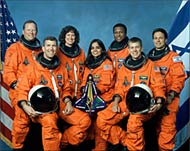NASA neglect caused Columbia crash
NASA’s self-protective culture and its reluctance to tackle safety problems head-on contributed to the fatal break-up of shuttle Columbia, independent investigators reported on Tuesday.

The Columbia Accident Investigation Board, set up after the 1 February tragedy that killed seven astronauts, said in its final report that NASA needed to set up separate safety agencies that would be able to get the attention of top space officials when things go wrong.
After seven months of work at a cost of about $20 million, the 248-page report recommended wholesale changes in how the National Aeronautics and Space Administration (NASA) does business.
 |
|
The Columbia seven who |
The recommendations include the creation of a Technical Engineering Authority funded directly from NASA headquarters to monitor safety outside the constraints of individual programme pressures.
Board Chairman Harold Gehman stressed at a briefing that the space shuttle fleet was not inherently unsafe, and praised NASA as an “outstanding organisation”.
Complacent
However, he said NASA needed to change how it monitors safety if the grounded shuttle fleet is to fly again, and must keep up safety standards over time, instead of growing complacent as it has in the past.
“There will be so much vigilance and so much zeal and attention to detail for the next half-dozen flights,” Gehman said. “The natural tendency of all bureaucracies to morph and migrate away from that diligent attitude is a great concern to the board, because the history of NASA indicates that they’ve done it before.”
|
“The natural tendency of all bureaucracies to morph and migrate away from that diligent attitude is a great concern to the board, because the history of NASA indicates that they’ve done it before” Harold Gehman, |
The board found that NASA engineers raised questions soon after Columbia’s launch on 16 January about a piece of foam insulation that was seen falling from the ship’s massive external tank about 81 seconds after lift-off.
Engineers asked three times during the 16-day mission for satellite images of Columbia in orbit to see if the foam struck and damaged the ship, but such images were never obtained.
The board’s report said NASA officials missed eight opportunities to address concerns about the falling foam, which was ultimately found to be the accident’s immediate cause.
“From the beginning, the board witnessed a consistent lack of concern about the debris strike on Columbia,” the report said. “NASA managers told the board ‘there was no safety-of-flight issue’ and ‘we couldn’t have done anything about it anyway.'”
Three other shuttles in the US fleet were grounded after Columbia disintegrated, and NASA chief Sean O’Keefe and others at the US space agency have estimated that next March or April is the soonest that the fleet can return to flight.